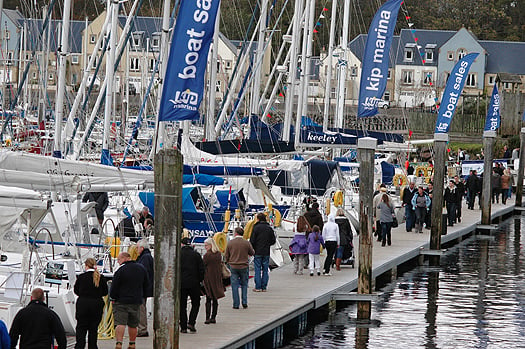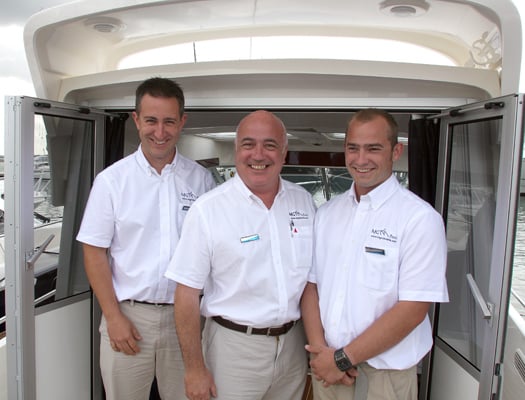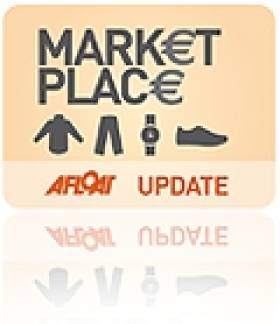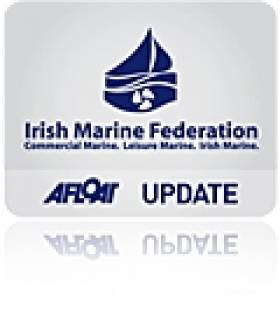Displaying items by tag: Show
Wales Boat Show Moves to Pwllheli in 2015
#pwllheli – Wales' biggest boat show moves to Pwllheli in 2015 - Wales' deputy tourism minister welcomes news of show's return
A boating and watersports show will return to North Wales next year thanks to growing interest in the event, it was announced today.
The All Wales Boat Show 2015 will take place in Pwllheli as one of the first events at Plas Heli, the new Welsh National Sailing Academy and Events Centre.
It follows two highly successful years in Conwy where it gained considerable interest from the marine and tourism sectors and attracted thousands of visitors over several days.
Organisers believe the All Wales Boat Show plugs a hole in the market and helps highlight the huge potential in Wales, where the marine leisure industry still only accounts for 2.4% of the UK as a whole, according to the British Marine Federation (BMF).
Ken Skates, Deputy Minister for Culture, Sport and Tourism welcomed the news. He said: "Building on the previous successes of this event, I am delighted that Pwllheli will be hosting the 2015 All Wales Boat Show. It is a wonderful opportunity to showcase Plas Heli, the town's £8.3m sailing academy and events centre.
"The marine leisure industry in Wales is a major player in terms of economic development and the Welsh Government is determined to see the marine leisure industry grow and endeavour to ensure that coastal communities will benefit from this expanding market."
The 2015 All Wales Boat Show will take place from Friday May 8th to Sunday 10th May.
Davina Carey-Evans, Managing Director of Wales Watersports International which operates the All Wales Boat Show, said opportunities were now open for sponsors, exhibitors and supporters.
Those already onboard include marine specialists GJW Insurance, Royal Yachting Association (RYA) Wales/Cymru, and marine law experts Hill Dickinson.
Davina said the show was indebted to Conwy and Deganwy Quay marinas for establishing the spectacle as an annual event.
"We have enjoyed two great years in Conwy but such was the success of this year's event we simply need more space for 2015," she said.
"Pwllheli offers this but keeps the event in Wales, close to some of this country's best coastline and inland waters, and to local economies which this sector supports.
2015 will be a big year for Pwllheli and the Llyn Peninsula with the opening of Plas Heli, the new Welsh National Sailing Academy and Events Centre, which has received an £8.3 million investment from the European Regional Development Fund through the Welsh Government and Gwynedd Council.
Davina added: "Wales has a spectacular, scenic coastline of natural beauty with many safe anchorages, harbours and marinas. The capacity for growth is recognised and if nurtured sensitively will provide excellent potential to stimulate the economies of coastal communities.
"We believe the show can be a big success, and put down a real marker for the huge potential of the marine sector in Wales and the positive impact it can have on our economy as a whole."
The All Wales Boat Show is designed to appeal to local, regional and international visitors.
In 2014 thousands flocked to the three-day event at Conwy Quay marina, which featured luxury yachts through to power boats, coracles and even bath tubs.
Boats were on show from Fairline Wales, Hanse, Jeanneau, Beneteaeu, Robalo, Chapparal, Quicksilver, Sunseeker and Bayliner, plus over 100 used vessels. The first boat was sold within minutes of the event opening its doors to the public.
According to the BMF, the marine leisure sector supported 7,600 full time-equivalent jobs in Wales in 2013.
With events such as the All Wales Boat Show, developments such as Plas Heli and marina expansions, these numbers are set to increase.
In addition to the All Wales Boat Show website at www.allwalesboatshow.com a new site, www.waleswatersports.com has been launched by the show organisers to act as a major portal for the marine and watersports sector in Wales.
Marine Federation agm for Dun Laoghaire
#BOATSHOW–The Irish Marine Federation (IMF) holds its Annual General Meeting at 18.00 on Wednesday, 30th November at the National Yacht Club, Dun Laoghaire.
Top of the agenda, in these challenging times, is the staging of next year's boat show which the board are keen to press ahead with in spite of the downturn. Options being discussed are a scaled back show as well as an on the water focus.
The AGM is open to all members of the IMF, whose subscriptions are up to date.
The meeting will be followed by drinks at the NYC bar.
25th Scottish Show Claims Bumper Crop of Irish Visitors
Opening its gates at 10am last Friday and the first boat being sold just 10 minutes later. Organisers confirmed to Afloat.ie that the numbers of visitors from both Ireland - north and south - was up on previous years. The buoyant feed back is a fillip for the marine leisure indsutry here and in the UK.

A busy pontoon during the show
The records continued to fall from there on with first day attendances more than double the previous year – a statistic which was to repeat throughout the show - ending up with a massive 12,000 visitors more than any previous show and bucking the trend elsewhere for declining visitor numbers at boat shows.
Scotland's Boat Show 2011 attracted visitors from all over Scotland, the North & South of England, Ireland and even from Europe but none could compare with the couple who arrived from New Zealand having added the show to their European itinerary after reading about it on the internet! They even had a chance to watch their beloved All Blacks play courtesy of Boat Electrics who were demonstrating satellite TV systems!
Throughout the show as the thousands of visitors flocked to Kip Marina to view the best and brightest of the boating world, it became apparent that exhibitors were also enjoying a bumper weekend – the Directors of Inspiration Marine who sell Hanse, Dehler and Moody yachts said "This is better than Southampton! We have done more business here in three days than we did in 10 days on the South Coast"
Prosser Marine MD Stan Prosser said "The 2011 Scotland's Boat Show has proved beyond doubt that if you are in the boating business anywhere, you need to be in Scotland every October!"
Boat sales during the show totalled an incredible £1.3m and, with many dealers having a diary full of viewings still to come, that figure will rise steeply over the coming weeks.
Scotland's Boat Show was officially opened by Education Secretary Mike Russell MSP who said of the shows 25th Anniversary, "Twenty-five years is a long time and the show has gone from strength to strength. What is really important is the strong impact it has on the local economy. We are talking about very serious money being spent here this weekend.
Kip Marina's Managing Director Gavin McDonagh said "With possibly the busiest day in Kip Marina's 40 year history, it is proof that the show has become the premier boat show in the North of the UK. We are delighted that all the exhibitors who have made the journey straight here from Southampton Boat Show had such a rewarding show and look forward to welcoming many more next year!
With so many attractions at this year's show – over 150 boats for sale, from a £500 dinghy to a half a million pound luxury motor yacht, more than 30 marine trade companies from all over the UK exhibiting the latest trends and products in the world of boats plus the chance to see 'Quantum of Solace' the 43' Sunseeker Superhawk powerboat from the James Bond film of the same name, a full range of Aston Martin and Rolls Royce motor cars together with the limited edition Volvo Ocean Racer 4x4's.
Sold! Boats are Selling Despite the Downturn
In 2007 there were 70 Irish yacht and boat sales staff manning stands in Southampton, this week that figure was down by about 60%. No one needs reminding of recession and the drop off in boat sales has been a reflection of the hard times.
Confidence is returning to the market in spite of the dire warnings about currency crises and dealers are now beginning to take trade ins again but they're still cautious as they have little room for error.
The good news though for boat owners is that there is now some great value in the market and the Southampton Boat show is an example of that. A core of about 15 Irish dealers are doing business there, thanks in no small part to the availability of marine finance again.

Boat Dealers James Kirwan (left) and Bernard Gallagher from BJ Marine on a new Benenteau Seanse in Southampton yesterday. BJ Marine are Irish Beneteau distributors
Interestingly, finance deals for values over €500,000 are 'brisk' but they remain sluggish for amounts under that, according to Afloat.ie's source.
That's surprising with the value of new craft on offer, such as a 2011 Beneteau Oceanis 48 footer at €209,000. A decade ago a boat with half that kit and of similar size would have been priced well over IR£350k. BJ Marine currently have three interested Irish parties in the 48 footer this week.
In essence dealers say that if you're prepared to drop your price on your trade in then you can probably make it back on a new purchase.
But just how much do asking prices need to drop? The amount varies between boat types but recently James Kirwan of BJ Marine sold a Beneteau Oceanis 39.3 for approximately €80k. An Oceanis 411 of the same vintage went for roughly €90k.
Alan Barton of MGM Boats in Kinsale sold a 2008 Jeanneau Sun Odyssey 39i recently for 125k. Two examples of nearly new Jeanneau Merry Fisher motorboats, a popular flybridge model in Ireland, fetched 75k and 85k approximately.

Martin Salmon (left) and Joe Hill welcome Alan Barton (centre) as the lastest broker to MGM Boats Ltd. Barton is running MGM Boats new brokerage office in Kinsale
Ironically, boat dealers have even been able to make progress through these bad times. Boats have not been as badly affected by the recession as other 'toys'. ' Unlike cars or property a boat is neither left hand drive or rooted to a particular spot making them easier to relocate and dispose of without resorting to fire sale prices' says BJ Marine's Bernard Gallagher.
In fact the worse the news grew about Ireland, the more business Irish dealers were able to do did as international buyers took advantage of the siutation to bag a bargain.
The trend is confirmed in part by the amount of search traffic coming from Scandinavia on leading Irish Boats for Sale sites such as Afloat.ie.
Swedish buyers are buying boats from 15k to 500k but most interest from Sweden is in five year old yachts in the 30-40 foot category.

Mark White, John O'Kane and Glyn Dewey from MGM Boats on the new Aquador 25 in Southampton. MGM are the UK and Irish distributors for the Finnish made Aquador motorboat marque
In terms of asset types, the old adage that if you want to make money buy a house, lose money buy a car or keep money buy a boat does not quite ring true thanks to the property crash but there's still some truth in it for boats.
'Over the last seven years I bought two apartments, a load of shares and the boat. The apartments are under water, the shares are gone but the boat's still worth something' that's what one rueful Irish boat owner told Afloat.ie yesterday.
The advent of boats for sale websites is allowing Europeans a European wide selection to choose from and Ireland has been the focus because of the good value.
Such has been the exodus of used boats from Ireland to overseas markets that Gallagher says there is a dearth of quality used large craft for sale in Ireland now.
The Southampton boat Show continues until Sunday but be warned the cost of flights from Dublin directly to Southampton for a day return this weekend are running at over €300!

































































